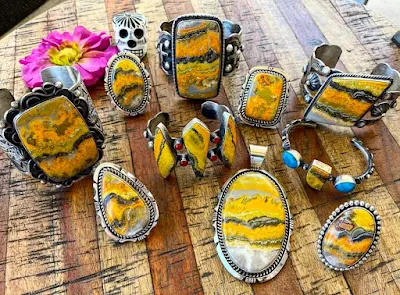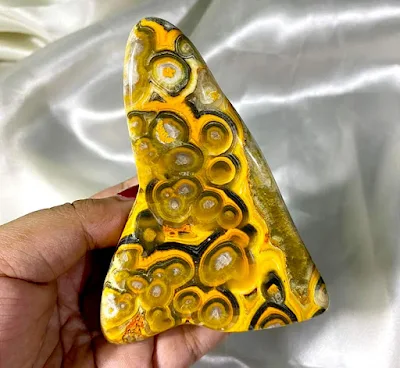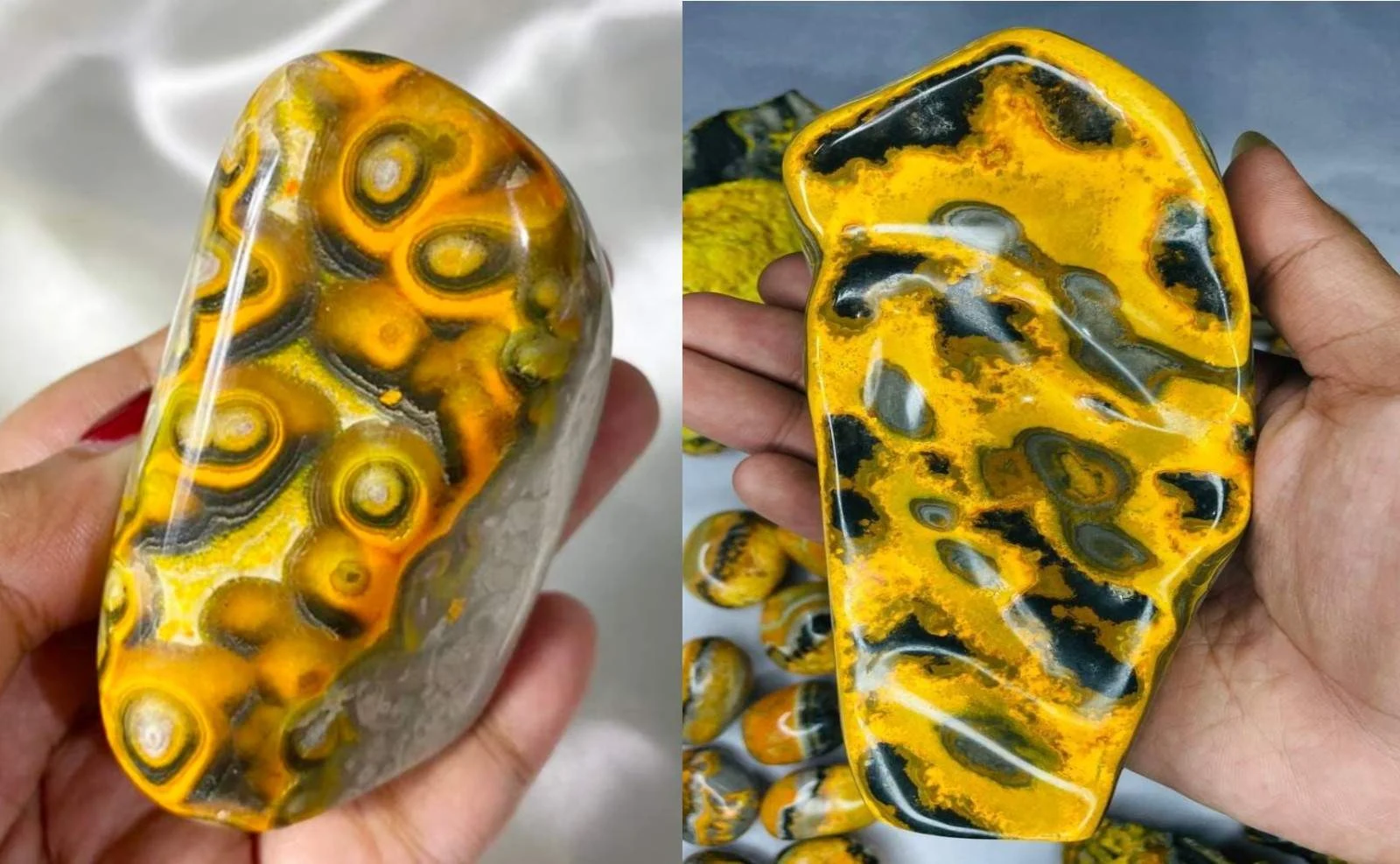Bumblebee Jasper: Gemstone, Properties, Uses
Bumblebee Jasper (also known as Bumble Bee Jasper) is a striking volcanic rock celebrated for its vibrant yellow, orange, and black banding, reminiscent of a bumblebee's colors. This rare gemstone is a relatively recent discovery, first found in the 1990s near the Papandayan Volcano in West Java, Indonesia. Despite its common name, it is not a true jasper but rather a fibrous
calcite-based sedimentary rock formed in volcanic environments.
Its unique appearance is due to its complex composition, which typically includes calcite colored by sulfur, arsenic sulfide minerals like realgar and orpiment, and manganese oxides, potentially alongside silica and pyrite.
Bumblebee Jasper Formation
Bumblebee Jasper is not actually a true jasper, but rather a distinctive rock primarily composed of fibrous calcite. It forms near volcanic vents or fumaroles from layers of volcanic ash and mineral-rich fluids deposited under heat and pressure associated with geothermal activity.
Its unique appearance and coloration stem directly from its mineral composition. The bright yellow hues are attributed to native sulfur, while the rich oranges often come from arsenic sulfide minerals like realgar and orpiment.
The characteristic black and dark gray bands are typically formed by manganese oxides (such as pyrolusite), not hematite as sometimes mistakenly suggested. These minerals are deposited in layers, creating the intricate banding and patterns that define the stone.
 |
| Natural Bumblebee Jasper |
The formation of Bumblebee Jasper is closely linked to volcanic activity, specifically occurring in fumarole environments (volcanic vents releasing gases and steam). Hydrothermal fluids – hot, mineral-rich water solutions interacting with volcanic rocks – play a crucial role. As these fluids circulate and cool, they precipitate the dissolved minerals like calcite, sulfur, arsenic sulfides, and manganese oxides onto existing rock surfaces or within cavities, building up the layered structure over time.
Chemically, Bumblebee Jasper is predominantly calcium carbonate (CaCO₃), with significant inclusions providing its color. Key coloring impurities include arsenic sulfides (such as As₂S₃ - Orpiment, or As₄S₄ - Realgar) and manganese oxides (like MnO₂ - Pyrolusite).
 |
| Rough Bumblebee Jasper. |
Properties of Bumblebee Jasper
Composition: Radially grown fibrous calcite with inclusions of realgar (arsenic sulfide) and pyrite (iron sulfide). It's not a true jasper, which is a chalcedony variety of quartz.
Color: Striking black stripes intertwined with vibrant yellow and orange bands, resembling a bumblebee. Can showcase variations like red or brown hues within the yellow or orange.
Luster: Can range from dull to waxy, depending on the type and density of inclusions. Polished Bumblebee Jasper often achieves a beautiful vitreous (glassy) shine on the yellow and orange areas.
Streak: White, like calcite.
Hardness: Bumblebee Jasper has a Mohs hardness of 3 to 5, making it softer than traditional jasper. Handle with care as it can be scratched or damaged easily.
Form: Typically found as massive, rounded formations or pebbles. Can form in botryoidal or stalactitic shapes in rare cases.
Transparency: Opaque to translucent, depending on the density and type of inclusions. Some areas with less intense colors might show slight translucency.
Solubility: Insoluble in most common solvents, but can be dissolved in acids like hydrochloric acid. Caution: Realgar is toxic, so handle Bumblebee Jasper with care and avoid ingesting or grinding it.
Magnetism: Non-magnetic.
 |
| Polished Bumblebee Jasper. Photo: BumblebeeJasper/IG |
Origin and Occurrence
Bumblebee Jasper is found exclusively in the Papandayan Volcano in West Java, Indonesia, and its rarity adds to its allure among gemstone enthusiasts and collectors. Despite its scarcity, Bumblebee Jasper is relatively affordable compared to other precious gemstones.
.jpg) |
| Natural bumblebee jasper from Indonesia |
Uses and Applications of Bumblebee Jasper
Bumblebee Jasper is a unique and vibrant gemstone known for its striking yellow, orange, and black color patterns. While it is primarily used in jewelry, it has gained popularity in various artistic and metaphysical applications. Here are some uses and applications of Bumblebee Jasper:
Jewelry: The most common use of Bumblebee Jasper is in jewelry making. It is often crafted into beads, cabochons, and pendants for use in earrings, necklaces, bracelets, and rings. The vibrant colors and unique patterns make it an eye-catching choice for those seeking bold and distinctive jewelry pieces.
Collectibles: Bumblebee Jasper is sought after by collectors due to its limited availability and distinctive appearance. Collectors may acquire specimens in various forms, such as polished cabochons, tumbled stones, or raw crystals.
Home Decor: Bumblebee Jasper can be incorporated into home decor items such as bookends, paperweights, or decorative bowls. Its vibrant colors can add a touch of warmth and visual interest to living spaces.
Lapidary Arts: Lapidarists and artisans may use Bumblebee Jasper to create intricate carvings, sculptures, or ornamental objects. Its unique patterns and color combinations make it an appealing choice for artistic expressions in various forms.
Metaphysical Practices:
Crystal healing: Believed to promote joy, optimism, creativity, and overcoming challenges. Can be used in meditation, rituals, or simply carried for personal connection.
Energy grids and layouts: Some incorporate Bumblebee Jasper to balance and enhance energy flow in specific spaces.
 |
| Bumblebee Jasper Jewelry |
In metaphysical practices, Bumblebee Jasper is incorporated into meditation and energy work. Bumblebee Jasper is associated with a variety of healing properties and metaphysical beliefs. It is believed to promote creativity, manifestation, and self-expression. Some believe it can boost energy levels, enhance willpower, and encourage optimism.Additionally, Bumblebee Jasper is thought to have a calming and grounding effect, helping to alleviate stress and anxiety.
 |
| Bumblebee Jasper |
Due to potential arsenic presence in some varieties, caution is advised. Avoid prolonged contact with raw or unpolished stones and opt for tumbled or polished pieces for safe handling.
In conclusion, bumblebee jasper transcends its captivating aesthetics to reveal a fascinating story of volcanic origins, intricate mineral composition, and potential applications beyond the realm of aesthetics.
 |
| Bumblebee Jasper |
See Also:
What is Mookaite Jasper
Jasper: Types and varieties of Jasper (Photos)
Ocean Jasper: Formation, Colors and Uses
Red Jasper - Properties and Uses

%20(1).webp)






